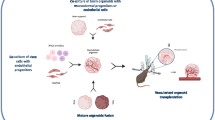Abstract
Newborn mice exposed to high (>98%) ambient oxygen during the newborn period and subsequently removed to room air will develop a proliferative retinopathy which mimics the neovascular component of acute retinopathy of prematurity. In this paper, we report preliminary ultrastructural findings on the vitreous new vessels in the mouse model of oxygen-induced retinopathy, and argue that the model is appropriate for research on non surgical treatments for ROP in particular and angiogenesis in general.
Similar content being viewed by others
Abbreviations
- ROP:
-
retinopathy of prematurity
- mouse model:
-
the mouse model of oxygen-induced retinopathy (described in full in text)
- HRP:
-
horseradish peroxidase
References
Garner A. The pathology of retinopathy of prematurity. In: Silverman WA, Flynn JT, eds. Retinopathy of Prematurity. Boston: Blackwell, 1985: 19–52.
Gyllensten LJ, Hellstrom BE. Experimental approach to the pathogenesis of retrolental fibroplasia I. Changes to the eye induced by exposure of newborn mice to concentrated oxygen. Acta Pediat 1954; 43 (suppl): 131–48.
Gerschman R, Nadig PW, Snell AC, Nye SW. Effect of high oxygen concentrations on eyes of newborn mice. Am J Physiol 1954; 179: 115–8.
Ashton N, Ward B, Serpell G. Effect of oxygen on developing retinal vessels with particular reference to the problem of retrolental fibroplasia. Br J Ophthalmol 1954; 38: 397–432.
Ashton N. Donders lecture: Some aspects of the comparative pathology of oxygen toxicity in the retina. Br J Ophthalmol 1968; 52: 505–31.
Bischoff PM, Wajer SD, Flower RW. Scanning electron microscopic studies of the hyaloid vascular system in newborn mice exposed to O2 and CO2. Graefes Arch Klin Exp Ophthalmol 1983; 220: 257–63.
Patz A, Eastham A, Higgenbotham DH, Kleh T. Oxygen studies in retrolental fibroplasia II. The production of the microscopic changes of retrolental fibroplasia in experimental animals. Am J Ophthalmol 1953; 36: 1511–22.
Miller H, Miller B, Zonis S, Nir I. Diabetic neovascularization: permeability and ultrastructure. Invest Ophthalmol Vis Sci 1984; 25: 1338–1432.
Gole GA. MD thesis: Oxygen-Induced Retinopathy. Sydney: University of NSW, 1989.
Tasman W. Retinal detachment in retinopathy of prematurity. In: Silverman WA, Flynn JT, eds. Retinopathy of Prematurity. Boston: Blackwell, 1985: 229–38.
Cryotherapy for Retinopathy of Prematurity Study Group. Multicenter trial of cryotherapy for retinopathy of prematurity. Arch Ophthalmol 1988; 106: 471–9.
Folkman J. Successful treatment of an angiogenic disease (editorial). N Engl J Med 1989; 320: 1211–12.
Gimbrone MA, Cotran RS, Leapman SB, Folkman J. Tumor growth and neovascularization: an experimental model using the rabbit cornea. JNCI 1974; 52: 413–27.
Adamson I, Jerdan JA, Lansing M, Martin GR, Glaser BM. Inhibition of neovascularization by a peptide analog of the cell-binding dominion of laminin. Invest Ophthalmol Vis Sci 1989; 30 (suppl): 391.
Phelps DL, Rosenbaum AL. Effects of marginal hypoxemia on recovery from oxygen induced retinopathy in the kitten model. Pediatrics 1984; 73: 1–6.
Patz A. Retrolental fibroplasia: experimental studies. Am J Ophthalmol 1955; 40: 174–83.
Ricci B, Calogero G. Oxygen-induced retinopathy in newborn rats: effects of prolonged normobaric and hyperbaric oxygen supplementation. Pediatrics 1988; 82: 193–8.
Gyllensten LJ, Hellstrom BE. Experimental approach to the pathogenesis of retrolental fibroplasia IV. The effects of gradual and rapid transfer from concentrated oxygen to normal air on the oxygen-induced changes in the eyes of young mice. Am J Ophthalmol 1956; 41: 619–27.
Patz A, Eastham AB. Oxygen studies in retrolental fibroplasia V. The effect of rapid vs. gradual withdrawal from oxygen on the mouse eye. Arch Ophthalmol 1957; 57: 724–9.
Gole GA, Belford DA, Rush RA. Laminin-like immunoreactivity in induced new vessels in kitten and mouse eyes. Aust NZ J Ophthalmol 1987; 15: 223–7.
Belford DA, Gole GA, Rush RA. Localization of laminin to retinal vessels of the rat and mouse using whole mounts. Invest Ophthalmol Vis Sci 1987; 28: 1761–6.
Author information
Authors and Affiliations
Rights and permissions
About this article
Cite this article
Gole, G.A., Browning, J. & Elts, S.M. The mouse model of oxygen-induced retinopathy: A suitable animal model for angiogenesis research. Doc Ophthalmol 74, 163–169 (1990). https://doi.org/10.1007/BF02482605
Accepted:
Issue Date:
DOI: https://doi.org/10.1007/BF02482605




